

Compact Muon Solenoid
LHC, CERN
| CMS-HIG-18-010 ; CERN-EP-2019-109 | ||
| Search for MSSM Higgs bosons decaying to $\mu^{+}\mu^{-}$ in proton-proton collisions at $\sqrt{s} = $ 13 TeV | ||
| CMS Collaboration | ||
| 6 July 2019 | ||
| Phys. Lett. B 798 (2019) 134992 | ||
| Abstract: A search is performed for neutral non-standard-model Higgs bosons decaying to two muons in the context of the minimal supersymmetric standard model (MSSM). Proton-proton collision data recorded by the CMS experiment at the CERN Large Hadron Collider at a center-of-mass energy of 13 TeV were used, corresponding to an integrated luminosity of 35.9 fb$^{-1}$. The search is sensitive to neutral Higgs bosons produced via the gluon fusion process or in association with a $\mathrm{b}\mathrm{\bar{b}}$ quark pair. No significant deviations from the standard model expectation are observed. Upper limits at 95% confidence level are set in the context of the $m_{\mathrm{h}}^{\text{mod+}}$ and phenomenological MSSM scenarios on the parameter $\tan\beta$ as a function of the mass of the pseudoscalar A boson, in the range from 130 to 600 GeV. The results are also used to set a model-independent limit on the product of the branching fraction for the decay into a muon pair and the cross section for the production of a scalar neutral boson, either via gluon fusion, or in association with b quarks, in the mass range from 130 to 1000 GeV. | ||
| Links: e-print arXiv:1907.03152 [hep-ex] (PDF) ; CDS record ; inSPIRE record ; HepData record ; CADI line (restricted) ; | ||
| Figures | |

png pdf |
Figure 1:
Leading order Feynman diagrams for the production of the MSSM Higgs boson: gluon fusion production (left) and b-associated production (middle and right). |

png pdf |
Figure 1-a:
Leading order Feynman diagram for the production of the MSSM Higgs boson: gluon fusion production. |
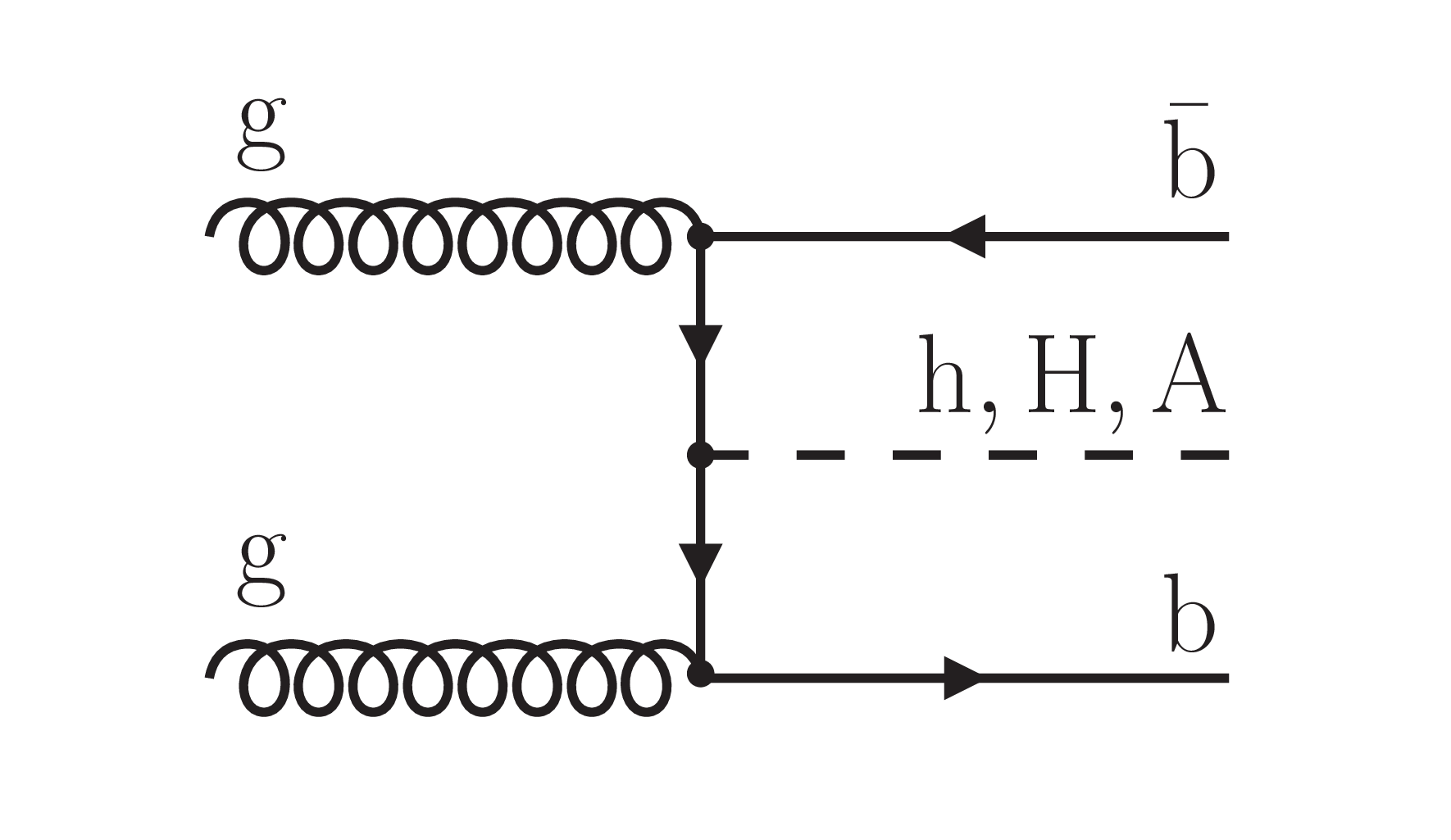
png pdf |
Figure 1-b:
Leading order Feynman diagram for the production of the MSSM Higgs boson: b-associated production. |
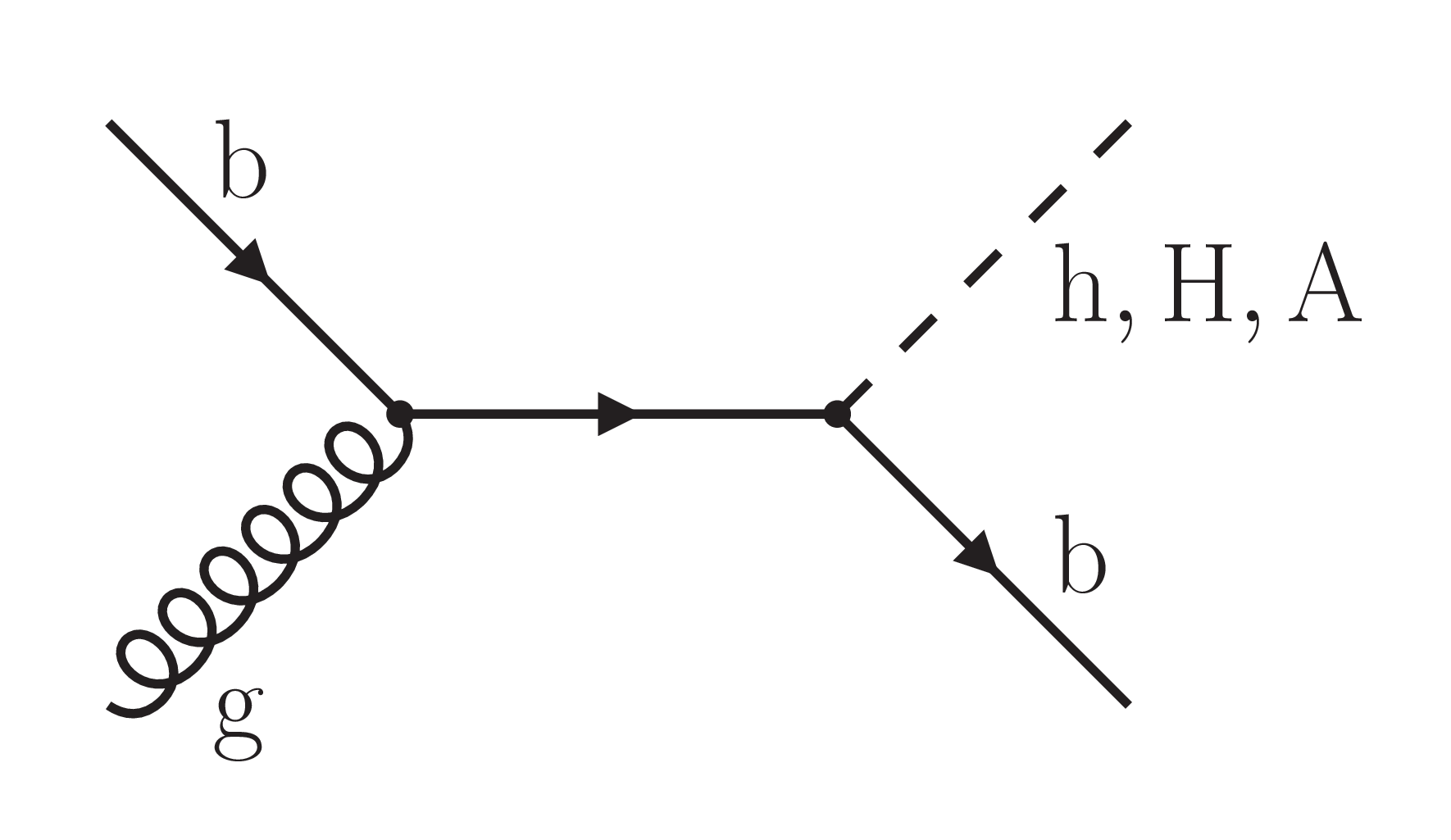
png pdf |
Figure 1-c:
Leading order Feynman diagram for the production of the MSSM Higgs boson: b-associated production. |

png pdf |
Figure 2:
Distribution of the missing transverse momentum in (left) b-tag and (right) no-b-tag categories, for events with dimuon invariant mass larger than 130 GeV, as observed in data (dots) and predicted by simulation (colored histograms). The shaded gray band around the total background histogram represents the total uncertainty in the simulated prediction. The contribution of the expected signal for $m_{{\mathrm {A}}} = $ 300 GeV and $\tan\beta = $ 20, scaled by a factor of 100, is superimposed for illustration. The vertical line represents the upper threshold used to select the events in the two categories. |
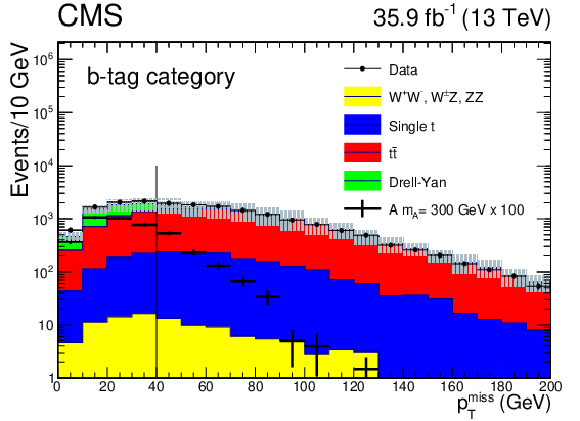
png pdf |
Figure 2-a:
Distribution of the missing transverse momentum in the b-tag category, for events with dimuon invariant mass larger than 130 GeV, as observed in data (dots) and predicted by simulation (colored histograms). The shaded gray band around the total background histogram represents the total uncertainty in the simulated prediction. The contribution of the expected signal for $m_{{\mathrm {A}}} = $ 300 GeV and $\tan\beta = $ 20, scaled by a factor of 100, is superimposed for illustration. The vertical line represents the upper threshold used to select the events in the category. |
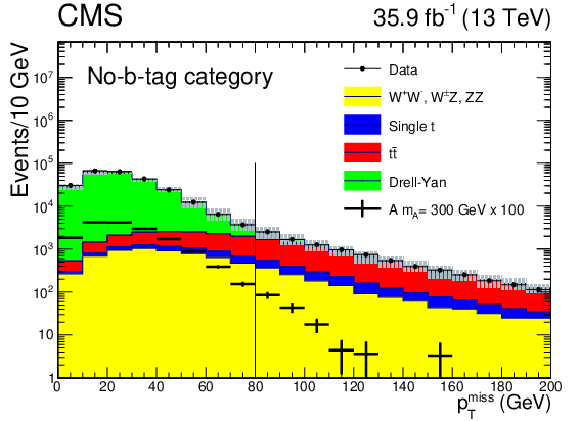
png pdf |
Figure 2-b:
Distribution of the missing transverse momentum in the no-b-tag category, for events with dimuon invariant mass larger than 130 GeV, as observed in data (dots) and predicted by simulation (colored histograms). The shaded gray band around the total background histogram represents the total uncertainty in the simulated prediction. The contribution of the expected signal for $m_{{\mathrm {A}}} = $ 300 GeV and $\tan\beta = $ 20, scaled by a factor of 100, is superimposed for illustration. The vertical line represents the upper threshold used to select the events in the category. |
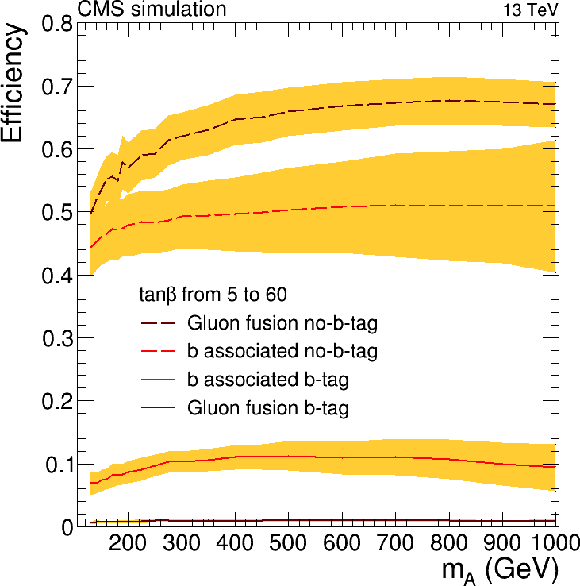
png pdf |
Figure 3:
The selection efficiency for the A boson, as a function of its mass, for the two production mechanisms, b-associated and gluon fusion, and for each of the two event categories. The band centered on each curve corresponds to the envelope of efficiencies obtained when varying $\tan\beta $, combined with the statistical and systematic uncertainties. |
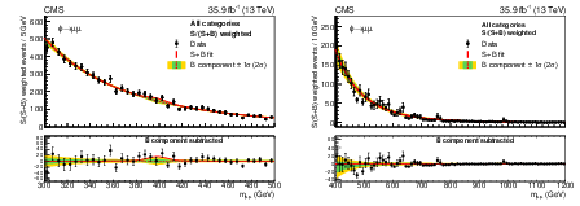
png pdf |
Figure 4:
Examples of fits to data with a signal plus background hypothesis, for a narrow-width signal with a mass of 400 GeV (left), and 980 GeV (right), for the two event categories added together, after weighting by their sensitivity. The resonance $\phi $ is assumed to be produced via the b-associated production, and to decay to two muons. The 68 and 95% CL bands, shown in dark green and light yellow, respectively, include the uncertainties in the background component of the fit. The lower panel shows the difference between the data and the background component of the fit. |

png pdf |
Figure 4-a:
Example of fit to data with a signal plus background hypothesis, for a narrow-width signal with a mass of 400 GeV, for the two event categories added together, after weighting by their sensitivity. The resonance $\phi $ is assumed to be produced via the b-associated production, and to decay to two muons. The 68 and 95% CL bands, shown in dark green and light yellow, respectively, include the uncertainties in the background component of the fit. The lower panel shows the difference between the data and the background component of the fit. |

png pdf |
Figure 4-b:
Example of fit to data with a signal plus background hypothesis, for a narrow-width signal with a mass of 980 GeV, for the two event categories added together, after weighting by their sensitivity. The resonance $\phi $ is assumed to be produced via the b-associated production, and to decay to two muons. The 68 and 95% CL bands, shown in dark green and light yellow, respectively, include the uncertainties in the background component of the fit. The lower panel shows the difference between the data and the background component of the fit. |

png pdf |
Figure 5:
The 95% CL expected, including the 68 and 95% CL bands, and observed upper limits, on $\tan\beta $ as a function of $m_{{\mathrm {A}}}$ for the $m_{\mathrm{h}}^{\text {mod+}}$ (left) and the hMSSM (right) scenarios of the MSSM. The observed exclusion contour is indicated by the purple region, while the area under the red curve is excluded by requiring the neutral h boson mass consistent with 125 $\pm$ 3 GeV. |
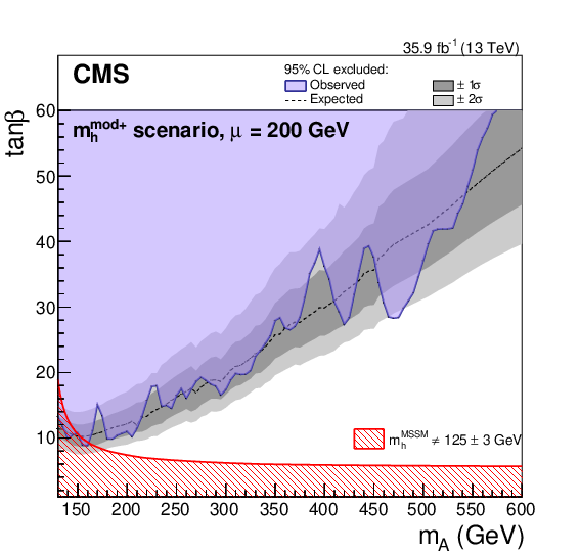
png pdf |
Figure 5-a:
The 95% CL expected, including the 68 and 95% CL bands, and observed upper limits, on $\tan\beta $ as a function of $m_{{\mathrm {A}}}$ for the $m_{\mathrm{h}}^{\text {mod+}}$ scenario of the MSSM. The observed exclusion contour is indicated by the purple region, while the area under the red curve is excluded by requiring the neutral h boson mass consistent with 125 $\pm$ 3 GeV. |

png pdf |
Figure 5-b:
The 95% CL expected, including the 68 and 95% CL bands, and observed upper limits, on $\tan\beta $ as a function of $m_{{\mathrm {A}}}$ for the hMSSM scenario of the MSSM. The observed exclusion contour is indicated by the purple region. |
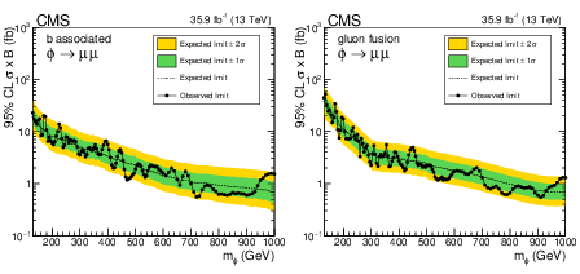
png pdf |
Figure 6:
The 95% CL expected, including the 68 and 95% CL bands, and observed model-independent upper limits on the production cross section times branching fraction of a generic $\phi $ boson decaying to a dimuon pair, in the case of b-associated (left) and gluon fusion (right) production. The results are obtained using a signal template with an intrinsic narrow width. |

png pdf |
Figure 6-a:
The 95% CL expected, including the 68 and 95% CL bands, and observed model-independent upper limits on the production cross section times branching fraction of a generic $\phi $ boson decaying to a dimuon pair, in the case of b-associated production. The results are obtained using a signal template with an intrinsic narrow width. |
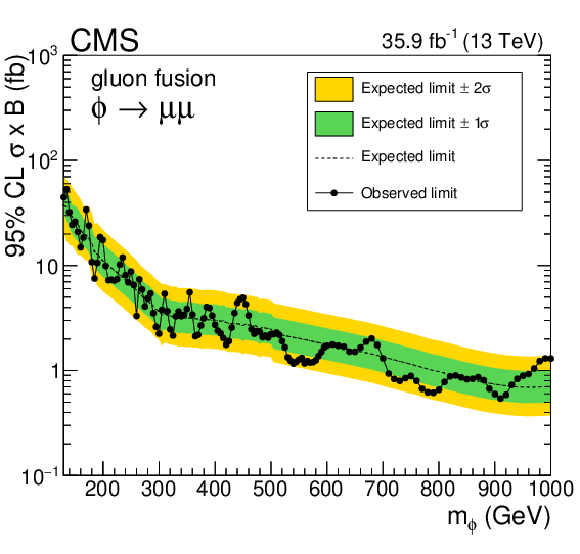
png pdf |
Figure 6-b:
The 95% CL expected, including the 68 and 95% CL bands, and observed model-independent upper limits on the production cross section times branching fraction of a generic $\phi $ boson decaying to a dimuon pair, in the case of gluon fusion production. The results are obtained using a signal template with an intrinsic narrow width. |
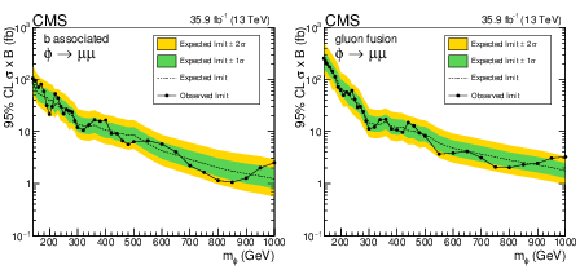
png pdf |
Figure 7:
The 95% CL expected, including the 68 and 95% CL bands, and observed model-independent upper limits on the production cross section times branching fraction of a generic $\phi $ boson decaying to a dimuon pair, in the case of b-associated (left) and gluon fusion (right) production. The results are obtained using a signal template with an intrinsic width equal to the 10% of the nominal mass. |
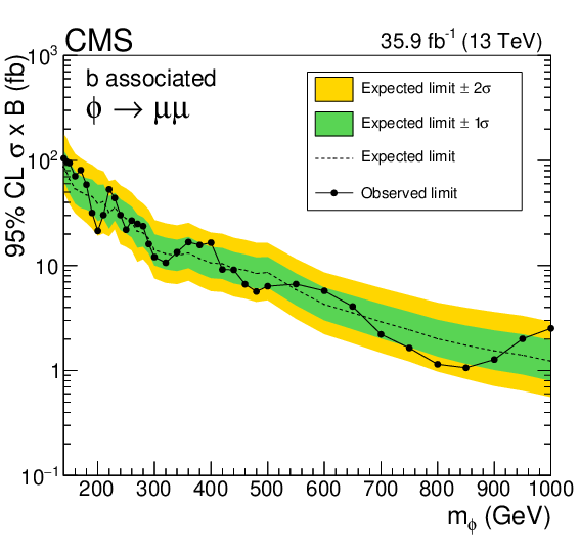
png pdf |
Figure 7-a:
The 95% CL expected, including the 68 and 95% CL bands, and observed model-independent upper limits on the production cross section times branching fraction of a generic $\phi $ boson decaying to a dimuon pair, in the case of b-associated production. The results are obtained using a signal template with an intrinsic width equal to the 10% of the nominal mass. |
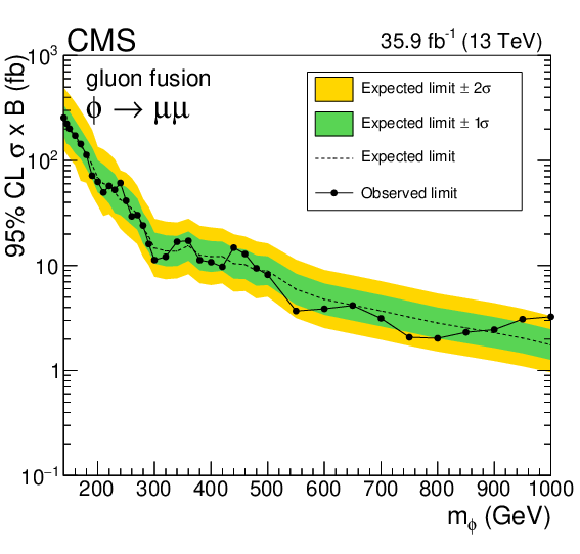
png pdf |
Figure 7-b:
The 95% CL expected, including the 68 and 95% CL bands, and observed model-independent upper limits on the production cross section times branching fraction of a generic $\phi $ boson decaying to a dimuon pair, in the case of gluon fusion production. The results are obtained using a signal template with an intrinsic width equal to the 10% of the nominal mass. |
| Tables | |

png pdf |
Table 1:
Summary of the muon selection criteria. |

png pdf |
Table 2:
Summary of the selection criteria that define the two event categories. Categorization is applied after the muon selection. |

png pdf |
Table 3:
Systematic uncertainties in the signal efficiency for the two event categories. The systematic uncertainties hold for both Higgs boson production processes except for the sources listed in the last three rows, which apply to the b-associated production process only. For these three sources, in the model-independent search for a neutral boson produced in association with b quarks, the uncertainties are applied as quoted in the table. In the MSSM interpretation, these numbers have to be weighted by the relative contribution of the b-associated production process to each category. For those sources of systematics that depend on $m_{{\mathrm {A}}}$ the range of uncertainty is quoted. |
| Summary |
| A search for neutral minimal supersymmetric standard model (MSSM) Higgs bosons decaying to $\mu^{+}\mu^{-}$ was performed using 13 TeV data collected in proton-proton collisions by the CMS experiment at the LHC. No excess of events was found above the expected background due to standard model (SM) processes. The 95% confidence level upper limit for the production of beyond SM neutral Higgs bosons is determined in the framework of the $m_{\mathrm{h}}^{\text{mod+}}$ and the phenomenological scenarios of the MSSM. For the ratio of the vacuum expectation values of the neutral components of the two Higgs doublets, $\tan\beta$, its excluded values range from $\approx$10 to $\approx$60 for a mass of the pseudoscalar A boson ($m_{\mathrm{A} }$) from 130 to 600 GeV. The larger collected luminosity and the higher center-of-mass energy exclude a larger $m_{\mathrm{A} }$-$\tan\beta$ region, compared to what was obtained at 7 and 8 TeV in a similar analysis. Model-independent exclusion limits on the production cross section times branching fraction of a generic narrow-width neutral boson decaying to two muons have been determined assuming the neutral boson to be produced entirely either via b-associated or gluon fusion mechanisms. The limits are determined in the mass range from 130 to 1000 GeV, separately for the two production mechanisms. Similarly, exclusion limits are also obtained assuming a signal width equal to 10% of its mass value. |
| References | ||||
| 1 | ATLAS Collaboration | Observation of a new particle in the search for the standard model Higgs boson with the ATLAS detector at the LHC | PLB 716 (2012) 1 | 1207.7214 |
| 2 | CMS Collaboration | Observation of a new boson at a mass of 125 GeV with the CMS experiment at the LHC | PLB 716 (2012) 30 | CMS-HIG-12-028 1207.7235 |
| 3 | CMS Collaboration | Observation of a new boson with mass near 125 GeV in pp collisions at $ \sqrt{s} = $ 7 and 8 TeV | JHEP 06 (2013) 081 | CMS-HIG-12-036 1303.4571 |
| 4 | ATLAS and CMS Collaborations | Combined measurement of the Higgs boson mass in pp collisions at $ \sqrt{s}= $ 7 and 8 TeV with the ATLAS and CMS experiments | PRL 114 (2015) 191803 | 1503.07589 |
| 5 | ATLAS and CMS Collaborations | Measurements of the Higgs boson production and decay rates and constraints on its couplings from a combined ATLAS and CMS analysis of the LHC pp collision data at $ \sqrt{s}= $ 7 and 8 TeV | JHEP 08 (2016) 045 | 1606.02266 |
| 6 | Yu. A. Golfand and E. P. Likhtman | Extension of the algebra of Poincaré group generators and violation of p invariance | JEPTL 13 (1971)323 | |
| 7 | J. Wess and B. Zumino | Supergauge transformations in four-dimensions | NPB 70 (1974) 39 | |
| 8 | P. Fayet | Supergauge invariant extension of the Higgs mechanism and a model for the electron and its neutrino | NPB 90 (1975) 104 | |
| 9 | P. Fayet | Spontaneously broken supersymmetric theories of weak, electromagnetic and strong interactions | PLB 69 (1977) 489 | |
| 10 | A. Djouadi | The anatomy of electroweak symmetry breaking. II. The Higgs bosons in the minimal supersymmetric model | PR 459 (2008) 1 | hep-ph/0503173 |
| 11 | M. Carena et al. | MSSM Higgs boson searches at the LHC: benchmark scenarios after the discovery of a Higgs-like particle | EPJC 73 (2013) 2552 | 1302.7033 |
| 12 | P. Bechtle et al. | Probing the standard model with Higgs signal rates from the Tevatron, the LHC and a future ILC | JHEP 11 (2014) 039 | 1403.1582 |
| 13 | M. Carena et al. | Complementarity between nonstandard Higgs boson searches and precision Higgs boson measurements in the MSSM | PRD 91 (2015) 035003 | 1410.4969 |
| 14 | L. Maiani, A. D. Polosa, and V. Riquer | Bounds to the Higgs sector masses in minimal supersymmetry from LHC data | PLB 724 (2013) 274 | 1305.2172 |
| 15 | A. Djouadi et al. | The post-Higgs MSSM scenario: Habemus MSSM? | EPJC 73 (2013) 2650 | 1307.5205 |
| 16 | A. Djouadi et al. | Fully covering the MSSM Higgs sector at the LHC | JHEP 06 (2015) 168 | 1502.05653 |
| 17 | H. Bahl et al. | MSSM Higgs boson searches at the LHC: benchmark scenarios for Run 2 and beyond | 1808.07542 | |
| 18 | CMS Collaboration | Measurements of the Higgs boson width and anomalous $ HVV $ couplings from on-shell and off-shell production in the four-lepton final state | PRD 99 (2019), no. 11, 112003 | CMS-HIG-18-002 1901.00174 |
| 19 | ATLAS Collaboration | Constraints on off-shell Higgs boson production and the Higgs boson total width in $ ZZ\to4\ell $ and $ ZZ\to2\ell2\nu $ final states with the ATLAS detector | PLB 786 (2018) 223 | 1808.01191 |
| 20 | ATLAS Collaboration | Search for the neutral Higgs bosons of the minimal supersymmetric standard model in $ {\mathrm{p}}{\mathrm{p}} $ collisions at $ \sqrt{s} = $ 7 TeV with the ATLAS detector | JHEP 02 (2013) 095 | 1211.6956 |
| 21 | CMS Collaboration | Search for neutral MSSM Higgs bosons decaying to $ \mu^{+} \mu^{-} $ in pp collisions at $ \sqrt{s} = $ 7 and 8 TeV | PLB 752 (2016) 221 | CMS-HIG-13-024 1508.01437 |
| 22 | ATLAS Collaboration | Search for scalar resonances decaying into $ \mu^{+}\mu^{-} $ in events with and without $ b $-tagged jets produced in proton-proton collisions at $ \sqrt{s}= $ 13 TeV with the ATLAS detector | Submitted to JHEP | 1901.08144 |
| 23 | ATLAS Collaboration | Search for neutral Higgs bosons of the minimal supersymmetric standard model in pp collisions at $ \sqrt{s} = $ 8 TeV with the ATLAS detector | JHEP 11 (2014) 056 | 1409.6064 |
| 24 | ATLAS Collaboration | Search for minimal supersymmetric standard model Higgs bosons $ \mathrm{H}/\text{A} $ and for a $ \mathrm{Z}^{\prime} $ boson in the $ \tau \tau $ final state produced in $ {\mathrm{p}}{\mathrm{p}} $ collisions at $ \sqrt{s} = $ 13 TeV with the ATLAS detector | EPJC 76 (2016) 585 | 1608.00890 |
| 25 | ATLAS Collaboration | Search for additional heavy neutral Higgs and gauge bosons in the ditau final state produced in $ 36 fb$^{-1} of $ {\mathrm{p}}{\mathrm{p}} $ collisions at $ \sqrt{s} = $ 13 TeV with the ATLAS detector | JHEP 01 (2018) 055 | 1709.07242 |
| 26 | CMS Collaboration | Search for neutral minimal supersymmetric standard model Higgs bosons decaying to tau pairs in $ {\mathrm{p}}{\mathrm{p}} $ collisions at $ \sqrt{s} = $ 7 TeV | PRL 106 (2011) 231801 | CMS-HIG-10-002 1104.1619 |
| 27 | CMS Collaboration | Search for neutral Higgs bosons decaying to tau pairs in $ {\mathrm{p}}{\mathrm{p}} $ collisions at $ \sqrt{s} = $ 7 TeV | PLB 713 (2012) 68 | CMS-HIG-11-029 1202.4083 |
| 28 | CMS Collaboration | Search for additional neutral MSSM Higgs bosons in the $ \tau\tau $ final state in proton-proton collisions at $ \sqrt{s}= $ 13 TeV | JHEP 08 (2018) 007 | CMS-HIG-17-020 1803.06553 |
| 29 | CMS Collaboration | Search for a Higgs boson decaying into a b-quark pair and produced in association with b quarks in proton-proton collisions at 7 TeV | PLB 722 (2013) 207 | CMS-HIG-12-033 1302.2892 |
| 30 | CMS Collaboration | Search for neutral MSSM Higgs bosons decaying into a pair of bottom quarks | JHEP 11 (2015) 071 | CMS-HIG-14-017 1506.08329 |
| 31 | CMS Collaboration | Search for beyond the standard model Higgs bosons decaying into a $ \mathrm{b\bar{b}} $ pair in pp collisions at $ \sqrt{s} = $ 13 TeV | JHEP 08 (2018) 113 | CMS-HIG-16-018 1805.12191 |
| 32 | The ALEPH Collaboration, The DELPHI Collaboration, The L3 Collaboration, The OPAL Collaboration, the LEP Working Group for Higgs Boson Searches | Search for neutral MSSM Higgs bosons at LEP | EPJC 47 (2006) 547 | hep-ex/0602042 |
| 33 | CDF Collaboration | Search for Higgs bosons predicted in two-higgs-doublet models via decays to tau lepton pairs in 1.96 TeV $\rm p\bar{p} $ collisions | PRL 103 (2009) 201801 | 0906.1014 |
| 34 | CDF Collaboration | Search for Higgs bosons produced in association with $ b $-quarks | PRD 85 (2012) 032005 | 1106.4782 |
| 35 | D0 Collaboration | Search for neutral Higgs bosons in the multi-$ b $-jet topology in 5.2 fb$ ^{-1} $ of $ \rm p\bar{p} $ collisions at $ \sqrt{s} = $ 1.96 TeV | PLB 698 (2011) 97 | 1011.1931 |
| 36 | D0 Collaboration | Search for Higgs bosons decaying to $ \tau\tau $ pairs in $ \rm p\bar {p} $ collisions at $ \sqrt{s} = $ 1.96 TeV | PLB 707 (2012) 323 | 1106.4555 |
| 37 | CMS Collaboration | The CMS experiment at the CERN LHC | JINST 3 (2008) S08004 | CMS-00-001 |
| 38 | T. Sjostrand et al. | An introduction to PYTHIA 8.2 | CPC 191 (2015) 159 | 1410.3012 |
| 39 | P. Nason | A new method for combining NLO QCD with shower Monte Carlo algorithms | JHEP 11 (2004) 040 | hep-ph/0409146 |
| 40 | J. Alwall et al. | The automated computation of tree-level and next-to-leading order differential cross sections, and their matching to parton shower simulations | JHEP 07 (2014) 079 | 1405.0301 |
| 41 | P. Artoisenet, R. Frederix, O. Mattelaer, and R. Rietkerk | Automatic spin-entangled decays of heavy resonances in Monte Carlo simulations | JHEP 03 (2013) 015 | 1212.3460 |
| 42 | R. D. Ball et al. | Unbiased global determination of parton distributions and their uncertainties at NNLO and at LO | NPB 855 (2012) 153 | 1107.2652 |
| 43 | CMS Collaboration | Event generator tunes obtained from underlying event and multiparton scattering measurements | EPJC 76 (2016) 155 | CMS-GEN-14-001 1512.00815 |
| 44 | GEANT4 Collaboration | GEANT4---a simulation toolkit | NIMA 506 (2003) 250 | |
| 45 | S. Heinemeyer, W. Hollik, and G. Weiglein | FeynHiggs: A program for the calculation of the masses of the neutral CP-even Higgs bosons in the MSSM | CPC 124 (2000) 76 | hep-ph/9812320 |
| 46 | S. Heinemeyer, W. Hollik, and G. Weiglein | The masses of the neutral CP-even Higgs bosons in the MSSM: Accurate analysis at the two-loop level | EPJC 9 (1999) 343 | hep-ph/9812472 |
| 47 | G. Degrassi et al. | Towards high-precision predictions for the MSSM Higgs sector | EPJC 28 (2003) 133 | hep-ph/0212020 |
| 48 | M. Frank et al. | The Higgs boson masses and mixings of the complex MSSM in the Feynman-diagrammatic approach | JHEP 02 (2007) 047 | hep-ph/0611326 |
| 49 | T. Hahn et al. | High-precision predictions for the light CP-even Higgs boson mass of the minimal supersymmetric standard model | PRL 112 (2014) 141801 | 1312.4937 |
| 50 | D. de Florian et al. | Handbook of LHC Higgs cross sections: 4. Deciphering the nature of the Higgs sector | CERN-2017-002-M | 1610.07922 |
| 51 | LHC Higgs Cross Section Working Group Collaboration | Handbook of LHC Higgs cross sections: 3. Higgs properties | CERN-2013-004 | 1307.1347 |
| 52 | M. Czakon and A. Mitov | Top++: A program for the calculation of the top-pair cross-section at hadron colliders | CPC 185 (2014) 2930 | 1112.5675 |
| 53 | R. Gavin, Y. Li, F. Petriello, and S. Quackenbush | FEWZ 2.0: A code for hadronic Z production at next-to-next-to-leading order | CPC 182 (2011) 2388 | 1011.3540 |
| 54 | M. Aliev et al. | HATHOR: HAdronic Top and Heavy quarks crOss section calculatoR | CPC 182 (2011) 1034 | 1007.1327 |
| 55 | P. Kant et al. | HatHor for single top-quark production: Updated predictions and uncertainty estimates for single top-quark production in hadronic collisions | CPC 191 (2015) 74 | 1406.4403 |
| 56 | J. M. Campbell, R. K. Ellis, and C. Williams | Vector boson pair production at the LHC | JHEP 11 (2011) 018 | 1105.0020 |
| 57 | CMS Collaboration | Particle-flow reconstruction and global event description with the CMS detector | JINST 12 (2017) P10003 | CMS-PRF-14-001 1706.04965 |
| 58 | CMS Collaboration | Performance of CMS muon reconstruction in $ {\mathrm{p}}{\mathrm{p}} $ collision events at $ \sqrt{s}= $ 7 TeV | JINST 7 (2012) P10002 | CMS-MUO-10-004 1206.4071 |
| 59 | CMS Collaboration | Performance of the CMS muon detector and muon reconstruction with proton-proton collisions at $ \sqrt{s}= $ 13 TeV | JINST 13 (2018), no. 06, P06015 | CMS-MUO-16-001 1804.04528 |
| 60 | M. Cacciari, G. P. Salam, and G. Soyez | The anti-$ {k_{\mathrm{T}}} $ jet clustering algorithm | JHEP 04 (2008) 063 | 0802.1189 |
| 61 | M. Cacciari, G. P. Salam, and G. Soyez | FastJet user manual | EPJC 72 (2012) 1896 | 1111.6097 |
| 62 | K. Rose | Deterministic annealing for clustering, compression, classification, regression, and related optimization problems | IEEE Proc. 86 (1998) 2210 | |
| 63 | CMS Collaboration | Identification of heavy-flavour jets with the CMS detector in pp collisions at 13 TeV | JINST 13 (2018) P05011 | CMS-BTV-16-002 1712.07158 |
| 64 | CMS Collaboration | The CMS trigger system | JINST 12 (2017) P01020 | CMS-TRG-12-001 1609.02366 |
| 65 | M. Cacciari and G. P. Salam | Pileup subtraction using jet areas | PLB 659 (2008) 119 | 0707.1378 |
| 66 | CMS Collaboration | Measurement of the inelastic proton-proton cross section at $ \sqrt{s}= $ 13 TeV | JHEP 07 (2018) 161 | CMS-FSQ-15-005 1802.02613 |
| 67 | ATLAS Collaboration | Measurement of the inelastic proton-proton cross section at $ \sqrt{s} = $ 13 TeV with the ATLAS detector at the LHC | PRL 117 (2016) 182002 | 1606.02625 |
| 68 | CMS Collaboration | Determination of jet energy calibration and transverse momentum resolution in CMS | JINST 6 (2011) P11002 | CMS-JME-10-011 1107.4277 |
| 69 | CMS Collaboration | CMS luminosity measurements for the 2016 data taking period | CMS-PAS-LUM-17-001 | CMS-PAS-LUM-17-001 |
| 70 | CMS Collaboration | Search for the Higgs boson decaying to two muons in proton-proton collisions at $ \sqrt{s} = $ 13 TeV | PRL 122 (2019) 021801 | CMS-HIG-17-019 1807.06325 |
| 71 | T. Junk | Confidence level computation for combining searches with small statistics | NIMA 434 (1999) 435 | hep-ex/9902006 |
| 72 | A. L. Read | Presentation of search results: The CL$ _s $ technique | JPG 28 (2002) 2693 | |
| 73 | The ATLAS Collaboration, The CMS Collaboration, The LHC Higgs Combination Group | Procedure for the LHC Higgs boson search combination in Summer 2011 | CMS-NOTE-2011-005 | |

|
Compact Muon Solenoid LHC, CERN |

|

|

|

|

|

|